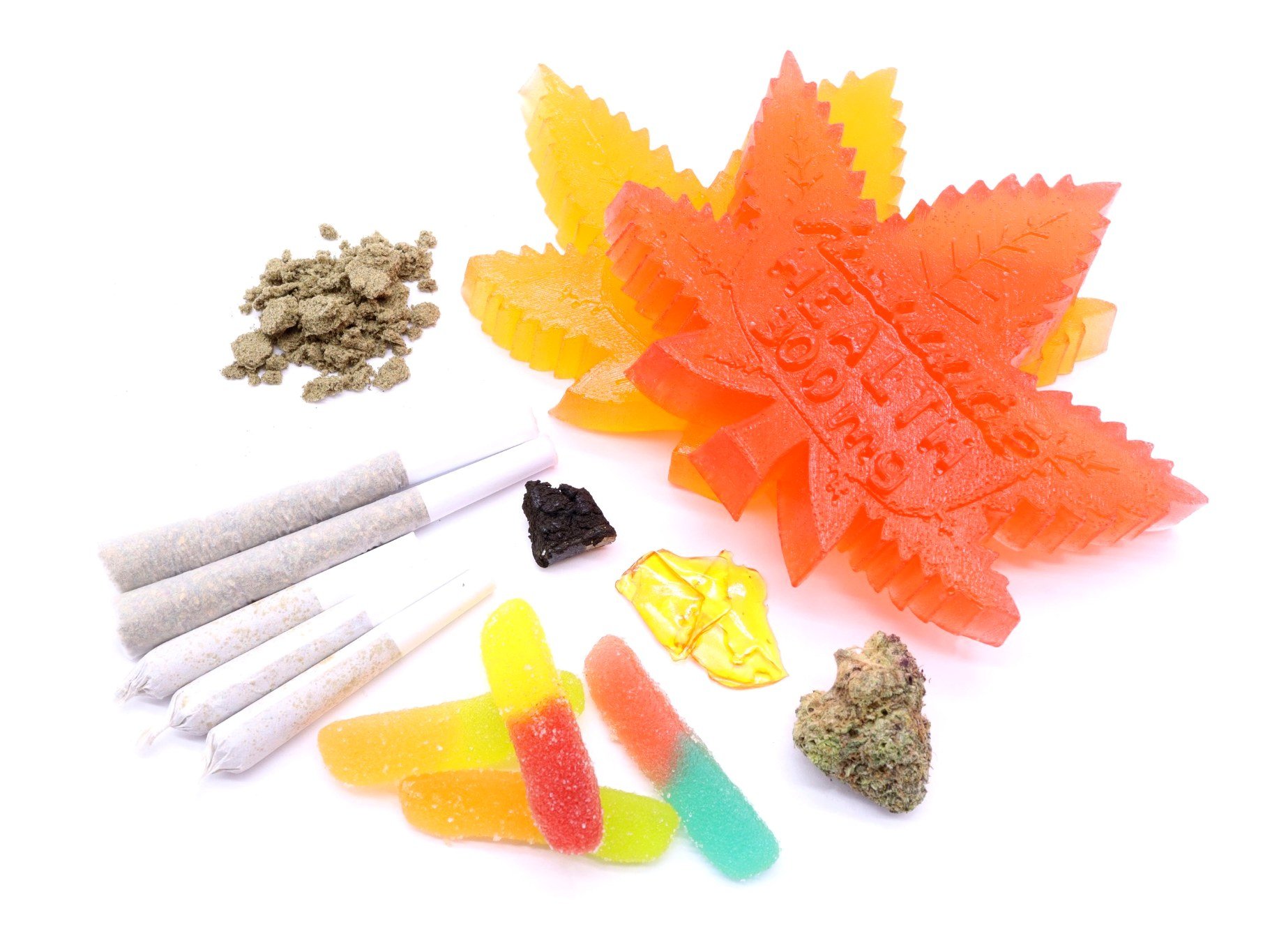Sometimes when we’re high, we get a little “philosophical” and wonder about the mysteries of life. Why does it seem like the moon is always looking directly at ME?! Did mushrooms come here on meteors and create the human race just to get back into space someday?! How long does it take the Blue Man Group to get painted, and then un-painted?! It’s funny, informative and a bit alarming where our minds can go when we’re under the influence of our favorite herb.
In fact, sometimes we look inwards at our psychoactive experience and begin to ask ourselves: How stoned am I? Is this a good high? Who am I?!
Okay, that last part typically happens after we’ve had a bit too much of old T-H-C, but the first two questions can shed some light on an important conundrum that many potheads have pondered for decades: what is the difference between being stoned vs getting high? There’s not a ton of research to rely on to help us answer “what does getting stoned mean?”, but we’re going to give this quizzical debate our best shot. First, we’ll review the different types of high, explore what being high is like, then wrap up our stoned vs high conclusions (if we can even find any!).
Pack a bowl with your most mind-expanding bud, roll some enlightening dro, dab some pontificating pot and prepare to wax philosophical with us as we delve for meaning in our stoned vs high experiences.
Different Types of High
The first and most crucial component of any high/stoned experience is this: they’re all variable. Everybody’s cannabis experiences are unique in some way to them, and no matter how we try to quantify or qualify the effects of cannabis on our brains & bodies there’s still some hidden magic to it all. You can smoke the same reefer your whole life, even grow your own and produce very consistent buds, and yet the effects you feel and the experiences you derive from consuming cannabis can vary greatly.
We’ve barely scraped the surface on how cannabis impacts our biochemistry. Heck, we know little-to-nothing about the plants themselves! Terpenes weren’t discovered until the 17th century by a German chemist, and since then we’ve only identified 150 or so, with many more thought to exist beyond the scope of our understanding.
Cannabis has been with humankind since our earliest days – we’re talking hundreds of thousands of years. We don’t know for sure if our progenitors consumed cannabis regularly, but there’s a lot of speculation that human beings and their genetic ancestors have sought out and even cultivated hemp & cannabis for thousands of years. To put this in perspective, the oldest written documentation that provides evidence of cannabis consumption comes from central Asia – 2500 year old wooden bowls were found in China and tested positive for traces of THC. Our stoned ancestors likely knew what they were doing, but did they have a clear picture of the benefits of cannabis, what it did to their brains & bodies, or did they perhaps understand their feelings while stoned or high?
We’re digging up all this historical cannabis use to help illustrate our point on the complexities of the different types of high. Even for as long as humankind has interacted with this wondrous weed, we still don’t have the foggiest idea on how to predict the kinds of psychoactive experiences this plant can have. So, there’s an important caveat to keep in mind throughout this article as well as throughout your cannabis journey: don’t get hung up on the details, just try to enjoy the experience to its fullest.
Now that we’ve got this asterix out of the way, what are the general categories of highs as we understand them today? Yours truly decided to summarize the many kinds of getting stoned vs being high into archetypes: Emotional and Functional.
Emotional highs are exactly that – linked to the intense emotions we feel/experience during our stoned-states. Happy, giggly, sad, angry, stoic or philosophical highs are just a handful of examples of these kinds of emotional cannabis experiences. You might assume that every time you get high you’re going to go through a wave of emotions – and the majority of the time you’d be right.
Here’s some examples of the most notable emotional highs that many of us cannabis aficionados have experienced:
Happy Stoned: Gleeful, cheerful, blissful cannabis highs are some of the best times of our lives. Simply put, when you get stoned and feel happy, life is awesome.
Funny Stoned: The giggles can overwhelm you, laughter comes easy and everything & anything seems hilarious. Sure, it can cause problems with your parents, bosses or law enforcement, but we could all use more laughter in our lives, right?
Sad Stoned: Nobody enjoys the depressing realizations, the long sighs and the downright dumps we find ourselves in sometimes when we get stoned. Nevertheless, through sadness we sometimes discover something new about ourselves or the world around us.
Rage Stoned: This kind of high isn’t enjoyable, especially for the people around you when it hits, but anger is sometimes what’s needed to help us channel our emotions when we’re dealing with stress.
Loving Stoned: Do you ever get high and instantly become the most cuddly, loving and friendly version of yourself? Like the ‘Happy High’, we think this version of getting stoned is tops.
On the flip side, certain psychoactive episodes serve more of a purpose than simply heightening your emotional state. These Functional stoned experiences occur when you become energized, your brain is bursting with creativity, or you become so relaxed to the point of drifting into an uninterruptible sleep. This archetype of getting stoned is characterized by engaging your mind or body into some kind of functional action (creating) or deriving a particular benefit (sleeping).
We put together a list of the most consistent/common types of functional highs that many of you stoners will be familiar with:
Relaxing/Chill High: One of the most consistent benefits of cannabis is its innate ability to chill us out, so this kind of high is highly sought after.
Creative High: To build, to draw, to compose, to write, to create while under the influence is another popular effect of many cannabis cultivars
Couch-Lock/Sleepy High: Sometimes the best thing about cannabis is that it knocks us out. Cannabis’ potent sleep-inducing effects not only help us to fall asleep but have been shown to support sleep quality, consistency and can improve your ability to dream (just be prepared for some wild, insightful stuff!)
Active High: Have you ever lit up a joint, expecting to just relax but suddenly feel enervated to the point of wanting to go, go, go?! This kind of functional high isn’t as common as couch-lock, but when it hits you’ll probably find your house is super clean and organized.
Paranoid High: We didn’t suggest that all of these kinds of psychoactive experiences were positive, did we? Paranoia isn’t pleasant, but it does serve a purpose. Our survival instincts can kick in, and while they’re rarely fun, feelings of paranoia can lead you to discoveries about yourself and the world around you. Just be careful you don’t let this kind of high go to your head too much.
As silly as this section might seem, we’re going to attempt to define “what does being high feel like” in as scientifically specific terms as we can. Without further ado, here’s the most official definition of what being high is like:
High, verb: To ‘get high’ is characterized by the psychological and physiological effects you experience while under the influence of substances like cannabis.
A cannabis-associated high is further categorized into two subgroups: Cerebral Highs and Physical Highs.
I. Cerebral psychoactive episodes are characterized by extreme headiness, introspection, chaotic storms of thoughts, emotions or memories, and a propensity for philosophical pondering.
II. Physical highs can be defined as the impacts of cannabis consumption – both beneficial and adverse – that influence your motor skills, reactiveness, and general bodily states.
Now, to demarcate what it is to be stoned:
Stoned, verb: To ‘be stoned’ is defined as the feelings, experiences, actions and reactions you encounter during the psychoactive influences of cannabis. To feel ‘stoned’ is associated with lethargy, laziness, feelings of intense relaxation or extreme sluggishness. Getting ‘stoned’ can lead to potent emotional responses from giddiness to depression. Feeling the effects of a ‘stoned episode’ often means hallucinating, intense thought patterns, complex emotions, introspection and out-of-body experiences.
There you have it folks, the definitive meanings for being stoned vs getting high. Clear as a hotboxed room full of smoke, right?
The Verdict: Stoned vs High
In locking down distinct definitions for being stoned vs getting high, we discovered that there’s no real difference – in medical or scientific terms – between the two. The terms for “being high” and “getting stoned” are both cultural phrases that came about over the years. While both are used differently, in essence they both mean the same things across a wide spectrum of cannabis experiences.
Some sophisticated stoners would disagree with this sentiment that there’s minimal differences between stoned vs high. For some, feeling high is the precursor to the much more intense effects of being stoned. Basically, many cannabis users refer to these different levels of cannabis effects as one leading into the other. For example:
Being high is like the early stages of giggling, your perceptions becoming hazy and the munchies starting to settle in. In this school of thought, what it’s like to be stoned is the next tier of cannabis effects: couch-lock, mind-numbing, out-of-body experiences and the like. In this writer’s humble opinion, this is approaching trivial status. If we’re arguing that being high feels like “headiness”, whereas getting stoned means “spaced out” then we’ve kind of lost the point.
There’s nothing wrong with believing in this distinct relationship between stoned vs high – we’re here to advocate quite the contrary. This blog set out to define the differences between what being high feels like and what getting stoned means. In our research and summarizing what we found, we’ve concluded that both “getting high” and “being stoned” are equally valid terms for how cannabis makes us feel. To you, a good high might be energetic, positive and profound whereas getting stoned can lock your butt to the couch and make you forget what year it is. That’s completely valid within the framework of your unique, personal experiences with cannabis. To others, the terminology used to describe how cannabis makes them feel or what it does to them mentally, physically, emotionally, and spiritually might not matter as much. The point is that we’re all indulging in this life-enhancing plant and exploring what it has to offer.
In summary, we hope that moving forward you focus less on the wording used – like the war of words overs marijuana vs weed vs pot vs dope vs cannabis! – and instead just share in the wonders of all this wonderful plant has to teach us.
FAQ
Is being stoned the same as high?
In essence, both mean the same kinds of experiences from consuming cannabis, but these terms are used differently by various cultures, nations and peoples.
What does being stoned mean?
The definition of being stoned is generally accepted as: “the effects and experiences one has while under the influence of particular substances, such as cannabis.”
What are the best feelings when you’re high?
The majority of cannabis consumers agree that feeling overly happy, giddy, giggly, loving and relaxed are some of the best feelings from getting stoned.
What’s the difference between a pothead and a stoner?
Both of these terms mean the same thing – a person who consumes cannabis frequently/consistently – but each has their own cultural significance.


